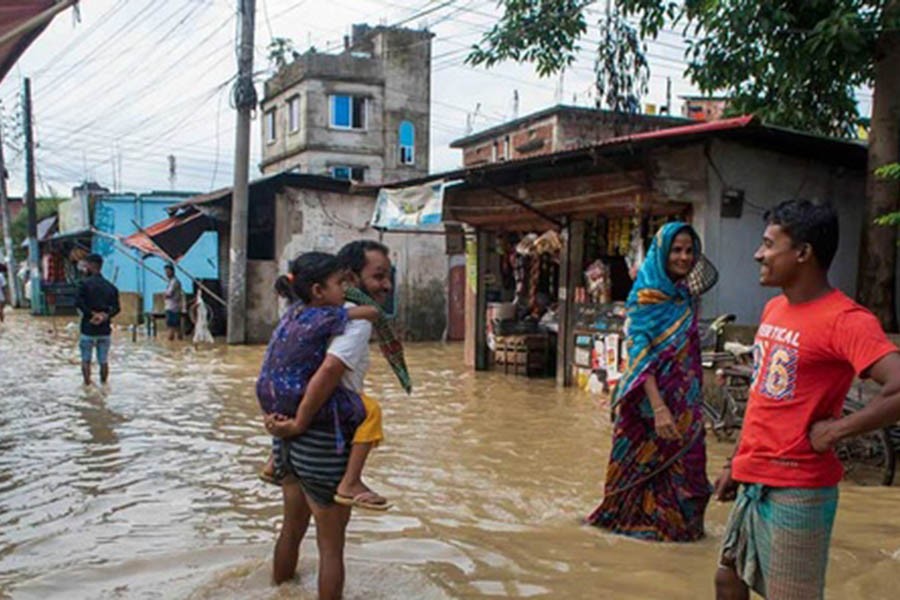
Published :
Updated :

Sylhet, hit by the worst flooding in a decade and a half, is struggling to supply food and drinking water to hundreds of residents.
Heavy rains and the onrush from upstream have triggered floods that have damaged homes in several parts of the district, reports bdnews24.com.
Food and drinking water crises are also intensifying with the surging water level, according to local residents.
Ramzan Ali, a sexagenarian resident of Alirgoan village in Sylhet’s Gowainghat Upazila, said he had last seen such heavy flooding in 2004 and expressed concern that the flood situation might be even worse this year.
At least 13 upazilas have been flooded, forcing the authorities to open 326 shelters across the district, the authorities said. As many as 7,349 people have taken refuge in 95 centres.
Local residents who have taken refuge in shelters said they have been facing a severe food and drinking water crisis as tubewells were flooded underwater and a three-day power cut disrupted the supply.
“They are all living through power outages,” Ramzan Ali said.
After losing her house to floods, Rashida Begum, a resident of a slum in Companiganj Upazila, moved to her brother-in-law’s house, which is also vulnerable to floods.
“I am afraid to sleep as snakes enter the house at night. I don’t have enough food for four children,” she said.
“The flood has damaged everything I had. Now I am fighting hunger after moving to the shelter as the food provided by the authorities isn’t enough,” said Rumina Akter, an elderly woman who has taken refuge at Thanabazar. Her house, built under the government housing project in Companiganj Upazila’s Kathalbari is flooded now.
A sudden onrush of mountain runoff from upstream has affected most of the areas close to the border, causing immense suffering to residents of the Companiganj, Gowainghat, Jointiapur, Zakiganj and Kanaighat upazilas. Floods have also damaged the transport system in those areas, forcing the authorities to close educational institutions.
“Schools were closed for almost two years due to the coronavirus pandemic. They have been closed again by the floods,” said Abdul Karim, a resident of Kanaighat Upazila’s Laxmi Prasad Union.
Floodwaters submerged parts of Sylhet after the breaching of 34 dams on the Surma and Kushiyara rivers, said Niloy Pasa, an assistant engineer at the Bangladesh Water Development Board.
After Sadar, Dakshin Surma, Companiganj, Gowainghat, Jointiapur, Zakiganj, Kanaighat and Fenchuganj Upazilas, floodwaters submerged parts of Beanibazar and Golapganj Upazilas.
“The Companiganj, Gowainghat and Kanaighat Upazila complexes have been flooded. Many shelters in those upazilas have also been affected,” Niloy said.
The water level at the Kanaighat, Sylhet and Sunamganj points of the Surma River was flowing 98 cm, 38 cm and 16 cm above the danger level, respectively, at 9 am on Friday.
In addition to Surma and Kushiyara, the water levels in the major rivers of the Upper Meghna Basin in the northeast of the country are rising and the surge will continue for 24 hours, according to the Flood Forecast and Warning Centre.
The water level of rivers in Sunamganj, Netrokona and Habiganj could flow above the danger level in the next 24 hours.
The flood situation may worsen in the low-lying areas of Sunamganj, but it may improve in Sylhet.
The authorities have distributed Tk 1.3 million, 234 tonnes of rice and 3,099 packets of dry food among the local people marooned by the floods, the district’s local government official Md Mozibor Rahman said.


 For all latest news, follow The Financial Express Google News channel.
For all latest news, follow The Financial Express Google News channel.